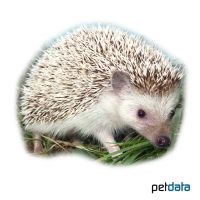Four-toed Hedgehog (Atelerix albiventris)
| Four-toed Hedgehog Atelerix albiventris | |
|---|---|
| Name | Four-toed Hedgehog |
| Name Lat. | Atelerix albiventris |
| Family | Gymnures & Hedgehogs |
| Family lat. | Erinaceidae |
| Order | Insectivores |
| Order lat. | Eulipotyphla |
| Origin | Africa |
| Climate | Subtropical - tropical |
| Habitat | Steppes, bushland |
| Diet | Insects, hedgehog food |
| Behavior | Nocturnal |
| Keeping | Individual |
| Care Level | Moderate |
| Life Span | 6-7 years |
| Protection | No |
| Metric Units | |
| Size | 17-23 cm |
| Temperature | Room temperature |
| Housing | A: 2 m² / H: 80 cm |
| US Units | |
| Size | 6.7"-9.1" |
| Temperature | Room temperature |
| Housing | 20 ft² / 30" hight |
Distribution and habitat
The nocturnal white-bellied pygmy hedgehogs are widespread in Central Africa from Senegal to Mauritania to Sudan and Zambia. They inhabit steppes, savannas, scrublands, fields and gardens, where they hide in rock crevices, caves or leaf piles during the day.
Maintenance
Minimum dimensions for the enclosure:
| 1-2 animals | area: 2 m² | height: about 80 cm |
For each additional animal, assuming species compatibility, the footprint must be increased by 1.5 m². The enclosure must be placed in a quiet, vibration-free place. Terrariums must not be tightly closed at the top
They need an enclosure structured with climbing and hiding places (branches, roots, hollow tree trunks, stones, cork tubes, etc.), wooden roosting boxes with nesting material (pellets, short straw), a drinking vessel and a deep substrate suitable for digging. Suitable substrate is e.g. a garden soil or sphagnum sand mixture, small animal litter and terrarium humus, but never mineral cat litter.
| room temperature: 23-27 °C | Temp. local: 35 °C | Minimum temp.: 18 °C |
Light sources that also produce the necessary heat are ideal. A natural day-night rhythm must be ensured. Red light is suitable for observation at night.
Diet
The diet consists mainly of insects, such as crickets, cockroaches, crickets, grasshoppers, earthworms, zophobas and mealybug larvae or a commercially available feed mix for insectivores (hedgehog food) and cat wet food, supplemented with boiled or steamed meat (chicken, turkey, beef), hard-boiled egg and very small amounts of fruit (bananas, apples, melons, etc.). Adult animals may occasionally be offered nest young mice, commercially available frozen. Since they are very picky, food is accepted differently from individual to individual. Regular addition of minerals and vitamins (dusting of food) is important. Drinking water must always be available in hanging bottles or in stable, open containers and, like food, must be offered fresh daily.
A varied diet promotes health and prevents deficiency symptoms.
Behaviour and compatibility
They are solitary animals. Same-sex keeping of several males or several females is possible in a well-structured enclosure. Males behave aggressively among themselves. At the first sign of incompatibility, separate the animals immediately.
Reproduction and breeding
In males, the distance between the anus and the urethral opening is greater than in females
Mating occurs shortly after the end of the resting period. After a gestation period of 30-35 days, 4-5 young are born, blind and naked. After about 10 days the eyes open. The young are independent after 6 weeks (end of suckling period) and sexually mature already after 2 months. The life expectancy can be 6-7 years.
Important
They are bred in numerous color strokes. Besides the standard colors, like Black, Salt & Pepper, Grey, Brown etc., there are also color variations (e.g. Snowflake) and color patterns (e.g. Pinto)
During the warm season, an outdoor enclosure should be available, which is closed all around and whose minimum dimensions correspond to those of the indoor enclosure.
The animals have lactose intolerance and therefore must not be fed with milk
During the 3-5 month resting period, they consume little food and sleep most of the time. Room temperature can be reduced to 18-20 °C during this time. Since they can only imperfectly regulate their body heat (similar to reptiles), the ambient temperature must never be below 15 °C, otherwise they will fall into a cold torpor
Care must be taken to ensure thorough hygiene, especially at the fixed defecation sites, and contamination must be removed regularly
Further literature can be found in your pet store.
References
Text: petdata; Image: petdata
Source: BMEL (2014): Gutachten über Mindestanforderungen an die Haltung von Säugetieren; W. PUSCHMANN, D. ZSCHEILE, K. ZSCHEILE (2009): Zootierhaltung - Tiere in menschlicher Obhut: Säugetiere, Harri Deutsch Verlag
- Gemäß § 21 Abs. 5 Tierschutzgesetz idgF
